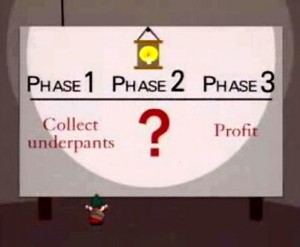In the last couple of weeks, we’ve had a few prospective clients approach us with something along the lines of “We already have a great Twitter presence, but we think we’re not making the most of it, can you help?”
When we take a look at the account, they have many thousands of followers. So, they’re convinced they have an asset there, it’s just a question of when to start “sweating” it.
The point of your Twitter account is…
These are all medium size companies, so it’s a safe assumption that they started out on Twitter with the aim of delivering some benefit to the organisation. It’s possibly a less safe assumption that anyone had articulated, even roughly, what exactly this benefit would look like.
So the account is created, and then someone finds out about this amazing automation software, something like Tweetspinner or Social Oomph. All you have to do is feed in a few general tweets which’ll be sent out at intervals, and the software will “grow your audience” by following other accounts, and unfollowing them after a while if they’ve not followed back. Do this for long enough, and you’ll have a big, healthy looking number under the “follower” count. Then good things will come.
Actually, that company has just joined the Twitter Underpants Gnomes. The Underpants Gnomes, for those not familiar with early South Park, steal pants as part of their bid for corporate world domination. Their big business plan reveal looks like this:

Incidentally, if we had a hundred pounds for each time we’ve seen something remarkably similar in a corporate presentation, we’d be retired. Anyway, back to Twitter: you get the point. There’s a gap in the plan which begins with “go on Twitter” and ends with “increase profit”.
All followers are far from equal
A fairly brief look at the activity around this company’s Twitter account reveals that things are not so good. The output consists of one way broadcast tweets, promoting the company’s offering. There’s not an @ reply or Retweet in sight. A search confirms that nobody has engaged with this account in living memory.
Examining the follower list, a very high proportion are similar looking accounts – large numbers of followers, but engaging with nobody. The automation club have a way of finding one another. Others are in markets where that company isn’t active, or are obviously spam accounts.
In a nutshell, if the Tweet “first one to reply gets a hundred pounds” were to be sent out from that account, you could be pretty sure that it’d be followed by the chirruping of a million virtual crickets.
Nobody is listening. So what that Twitter account is likely to achieve for the business is…absolutely nothing. It has literally zero value.
The way that people use Twitter is still very much evolving, and we hope that the “numbers game” approach is going to die out as people start to ask these sorts of questions about how the account is meant to deliver value.
If you’re a superstar global brand, thousands of followers are there for the taking, provided you do a reasonable job with your outbound content (and in some cases, even if you don’t). But for most businesses, an account with even a handful of really engaged followers, would be hugely more valuable in terms of almost any business goal. Those engaged followers might well be a subset of a much bigger list, but they absolutely have to be there.
What do you think? How do you grow your audience? Do you use automation software on your own account?
Enjoyed this post? Why not ![]() subscribe to our blog, or
subscribe to our blog, or ![]() follow us on Twitter?
follow us on Twitter?






I have a very small list, but it’s all peopled I’ve vetted, and I will follow people I’ve met. I still love reading the stream of tweets and do some searching, but most people join my e-list and that’s how word spreads about what I’m doing.
Hi Albert, I think for many people that’s the way to develop a really good Twitter network, rather than just have a big number by your username! Thanks for your comment.
Hi – I absolutely agree with you re quality vs quantity.
I’ve just started our company’s Tweeting and I haven’t got a clue what happened a couple of days’ ago but somehow, we picked up a bevvy of about 20+ stetson wearing beauties from Nashville who can sing! IMHO there’s no way these women are going to be interested in what my company has to offer here in New Zealand… but if I was ranking my “success” totally on quanitity I’d be a winner!
However, having said that, if they were C&W singers from NZ I wouldn’t be concerned because they’d be part of my target market (ie, Kiwis).
Size isn’t everything!
Smiles, julie@halobiz.co.nz
Hi Julie, that does sound like a LOT of singing stetson wearers!! Unlikely to assist your business, but maybe some kudos for brightening up your day!?
Thanks for stopping by
[…] 8. # On the other hand you may already have thousands and thousands of Twitter followers, but ‘Is your Twitter account worthless?’ […]
[…] 8. # On the other hand you may already have thousands and thousands of Twitter followers, but ‘Is your Twitter account worthless?’ […]
I believe it is how you use the tool (twitter) and if you use the way it was intended it will work. Quality over quality. It was built to interact and the one author that has nailed this topic is Scott Stratten @unmarketing. His book is great and gets to these topics and explains why it works and why it will not for others. Check it out. I am still working on adjusting as I continue to build on what I learn from guys like Scott.
Hi AJ, We absolutely agree with Scott’s work – what we’re seeing with these “big” (ie thousands of followers) broadcast only accounts is exactly the reverse of that, completely missing the point of what Twitter was designed for. Thanks for your comment.
I agree with you on most of your points — the company I work for does not use any sort of automation software. We try to place an emphasis on the ‘social’ aspect of social media and when people are doing what you described, that’s virtually impossible. Here’s something to think about tho: what if you did join one of those infamous “add your Twitter account and we’ll follow!” groups on LinkedIn or what have you, and then added whoever you thought to be beneficial to your company. Working for a relatively small B2B company, I would think this wouldn’t hurt — in fact, I think it would be a beneficial method in our case. Thoughts?
Hi Krissy – thanks for coming over, it’s lovely to see what a lively debate this article sparked on LinkedIn! And you’re right of course, there’s no absolute harm in participating in those threads; with the reach of social media, there’s never any way to be certain where a connection might lead.
Plus, it very much depends on your company’s offering – the odds of coming across a useful contact if you’re, say, a tree surgeon working within a 20 mile radius of a small town, would be wildly lower than they would if you were a web hosting company operating globally?
great article! Most people have this idea that many followers equal increased traffic or sales, when nothing can be further from the truth. Not until i was able to interview a famous rockstar drummer did my traffic increase. To be honest , credibility is built on hard work and longevity. I believe in the nothing say what you do , and do what you say to gain trust . If you can stick around for a long time you build brand loyalty and credibility. There is no substitute unfortunately.
Thanks Manny – We’ll add “interview rockstar drummer” to our list of “how to get ahead on Twitter” tips 😉
I read a statistic that 75% of tweets are unread. (Of course, I have also read that 78% of statistics are made up on the spot). I’m in the midst of published a 5-part series titled “All You Ever Wanted to Know About Coupon Marketing”, a topic that I know many are interested in. Three or four of the acknowledged Internet localization experts have tweeted on my behalf, along with my own, and pickup has been very slow so far. Of course that’s not the only way that we are promoting the blog series, but my traffic logs show very little from Twitter. I think it’s largely a waste of time.
John, I think it depends on how your run your account – if it’s done as described above, 100% of tweets will be unread! Everyone’s mileage will vary of course, but on an average week we get around 25% of our website traffic via twitter referrals, and many of our clients likewise.
couldn’t agree more – there is a lot of moneybeing spent (in time) building random followers, but unless you develop a relationship with these followers it is meaningless
Amen! thanks for your comment Angela.
Hi, as a linkedin and twitter novice (ie just have joined both, but really have no idea of what to do with either) this makes very interesting reading. I’m in the process of getting a website designed for a new business venture (I currently work in the public sector so this is all new to me) and I’m wondering what, if anything, I should be doing to use Linkedin and twitter – any ideas ?
Hi Sarah – happy to help, but will need a few more details and it’ll be a bit long to go into here – drop us an email with an outline of the business venture, and we’ll give you a few suggestions.
We agree. Quantity is not quality. Now, of course we’d love to have lots of followers for our clients’ Tweets, but only if they are in their geo area and have a need for the product or service. We don’t subscribe to the theory that all followers who are far away have mothers, brothers or friends in our clients’ market who are just ready to buy. Or, that folks following us because they want to sell something (perhaps something a little racy) to our clients’ followers should be followed by us in turn. In marketing, the right content to the right people will always win.
I am going to resonate what you have already outlined, but the fault is not only with the automation software, at times you find people who want to get followers and fans without realising that the sheer growth in numbers won’t give them the appropriate result.Rather a consistent and well framed marketing campaign might do what these so called short cuts can’t even think of.
Yes, it’s important that the client understands the full story about follower numbers, so that doesn’t become a key objective for a social media campaign, absolutely.
Hi, I agree with you, quality is far more important than quantity. This blog post takes a slightly different approach but has the same sorts of ideas – http://thatsconsulting.com.au/to-follow-or-not-follow
I am 100% agree with you. I have spent a few weeks try to figure out what’s the best strategy to use twitter and facebook to promote my business. I have read all the information about social media marketing from twitter, facebook and linkedin, then I have a concolution that: most of the social accounts are created for spamming. People just want to build the “numbers” to make them feel good. Think about it: if you follow 100 companies, if each company send you one update per day, their post will show up on your News feed, what’s the chance you are going to read them? and how much time do you need to spend to read? If your followers don’t have any real interest on your products or services, why do you need them to be your followers? It will make you feel good, but you won’t benefit from it.
Hi David
We always wonder how long the “feel good” factor of large follower numbers really lasts, once people start to realise that engagement is key!
You’re in a tough business for online marketing though – much harder to differentiate yourself when so many of your competitors are already flooding the web with info. IMO any “offline” business has it easier…
Great article Rose. Everyone who trains companies to use Twitter should have this embedded on their forehead.Beware of the cowboys out there – use Rose McGrory and be safe!!
Naturally we agree with your wise words Ian, thanks for stopping by 😉